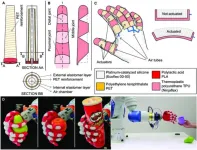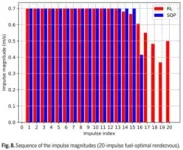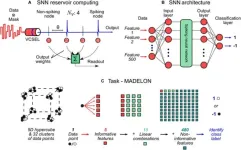(Press-News.org)
A research paper by scientists at the University of Coimbra proposed a soft robotic hand that composed of soft actuator cores and an exoskeleton, featuring a multimaterial design aided by finite element analysis to define the hand geometry and promote finger’s bendability. The new research paper, published on Aug. 8 in the journal Cyborg and Bionic Systems, presented the development, fabrication, and control of a bioinspired soft robotic hand and demonstrated finite element analysis can serve as a valuable tool to support the design and control of the hand’s fingers.
“Recent research led to impactful achievements in functional designs, modeling, fabrication, and control of soft robots. Nevertheless, the full realization of life-like movements is still challenging to achieve, often based on trial-and-error considerations from design to fabrication, consuming time and resources. Using finite element analysis to support the design process, saving time and resources”, explained study author Pedro Neto, a professor at the University of Coimbra. The finite element analysis comprising (a) hyperelastic behavior of the soft materials, (b) finite rotation and large strain of the exoskeleton and actuators, and (c) frictional contact between exoskeleton and actuators. “This integrated solution will make soft robotic hands more available to people, at a reduced cost, avoiding the time-consuming design-fabrication trial-and-error processes”, said authors. Thus, they proposed a soft robotic hand that composed of soft actuator cores and an exoskeleton, featuring a multimaterial design aided by finite element analysis to define the hand geometry and promote finger’s bendability.
Soft robots can be fabricated by using multiple materials and using different manufacturing processes, ranging from silicone molding to 3D printing. 3D printing methods bring significant benefits in design and fabrication, making it easy to introduce complex geometries within soft robots, accelerating/automating the fabrication process, and reducing its cost. “3D printing allows the introduction of sensing and control elements within the robot, promoting innovation in multiple application domains", said Alves.
The study authors showed that the multimaterial soft actuators are designed and fabricated at a reduced cost and time effort, using standard fabrication processes such as molding and single-step 3D printing. The ON–OFF controller, while simple, keeps the set fingers bending angles stable, even in the presence of leaks. The robotic hand demonstrated dexterity and capability to grasp objects with different shapes, weights, and sizes.
“The reinforcement in a circumferential direction guarantees the actuator's elongation and consequently the fingers bent when inside the exoskeleton. The robotic hand achieved an interesting dexterity level, being able to grasp objects of different shapes and sizes. Nevertheless, it struggles to grasp heavier objects featuring slippery surfaces, showing a concentrated deformation at the base of the fingers while the thumb motion is constrained. In addition, depending on the grasping surface and geometry, there exists mechanical interference between the fingers. Since the soft hand is highly nonlinear, with most variables of interest being coupled between themselves, future work will be dedicated to an in-depth analysis of the grasping phenomena together with further standardization of testing benchmarks,” said Alves. Totally, this soft robotic hand is accessible and can be built at a reduced cost, avoiding the time-consuming design-fabrication trial-and-error processes, and inspiring innovation around it.
Authors of the paper include Samuel Alves, Mihail Babcinschi, Afonso Silva, Diogo Neto, Diogo Fonseca, Pedro Neto
Portuguese national funds through FCT—Fundação para a Ciência e a Tecnologia (grant numbers UIDB/00285/2020, LA/P/0112/2020, and 2022.13512.BD).
The paper, “Integrated Design Fabrication and Control of a Bioinspired Multimaterial Soft Robotic Hand” was published in the journal Cyborg and Bionic Systems on Aug 8, 2023, at DOI: 10.34133/cbsystems.0051.
END
Multi-impulse orbital rendezvous is a classical spacecraft trajectory optimization problem, which has been widely studied for a long time. Numerical optimization methods, deeplearning (DL) methods, reinforcement learning (RL) methods have been proposed. However, for the numerical optimization methods, they need long computation time, and they are usually not valid for the many-impulse rendezvous case with the magnitude constraints. For the machine learning (ML) methods, the DL method needs large amounts of data, and the RL method has the weakness of low efficiency. Nevertheless, ML demonstrates more accurate predictions ...
SAN ANTONIO — September 12, 2023 —The Association of Old Crows (AOC), an international organization for the electronic warfare (EW) community, has recognized three early-career Southwest Research Institute engineers for their achievements in EW research and development. Two honorees received back-to-back Electronic Warfare Professional Outstanding Young Crow Awards. AOC named one engineer a 2023 Future 5, a designation for innovative professionals building EW careers. EW technology detects and defeats enemy signals on the electromagnetic spectrum to protect U.S. and allied forces.
Recipients of the international AOC EW Professional Outstanding Young Crow Award demonstrate outstanding ...
BATON ROUGE – The National Institutes of Health has awarded the Louisiana Clinical & Translational Science Center, or LA CaTS, a grant of nearly $1.3 million to support the efforts of in-state healthcare institutions to share health data for research purposes across a common structure.
Awarded as a single grant, the funds will be primarily split between two LA CaTS member institutions: nearly $780,000 for the Pennington Biomedical Research Center and $490,000 for Tulane University School of Medicine. Together, these two projects will strengthen the LA CaTS Center’s capacity to address health care disparities, ...
Photonic neural network systems, which are fast and energy efficient, are especially helpful for dealing with large amounts of data. To advance photonic brain-like computing technologies, a group of researchers at the University of Strathclyde combined a spike-based neural network with a semiconductor laser that exhibits spiking neuronal behaviors. Recently, they presented high-performance photonic spiking neural network operation with lower training requirements and introduced a novel training scheme for getting better results. This research was published Aug. 29 in Intelligent Computing, a Science Partner Journal.
Neural ...
September 12th, 2023
For immediate release
Fom the bestselling author of Post-Truth and How to Talk to a Science Denier, comes On Disinformation: How to Fight for Truth and Protect Democracy
The effort to destroy facts and make America ungovernable didn't come out of nowhere. It is the culmination of seventy years of strategic denialism. In On Disinformation, Lee McIntyre shows how the war on facts began, and how ordinary citizens can fight back against the scourge of disinformation that is now threatening the very ...
Sepsis, also colloquially referred to as blood poisoning, is a serious condition. Just over 3,000 people die with a diagnosis of sepsis in Norwegian hospitals each year.
However, sepsis is not actually poisoning at all. The condition occurs when the immune system overreacts to an infection that can be caused by bacteria, viruses, fungi or parasites. The immune system attacks the organs of the body and the patient develops organ failure.
A new study of 300,000 sepsis admissions has found that the condition is more prevalent than previously thought. However, ...
Mount Sinai researchers have developed a novel, automated measure of analyzing sleep studies to determine the severity and risk of mortality in patients with obstructive sleep apnea, a chronic sleep disorder that affects about 30 million people in the United States. The study findings, which provide a validated tool to better manage sleep apnea and promote preventive care, were published in the American Journal of Respiratory and Critical Care Medicine on September 12.
The Mount Sinai Sleep and Circadian Analysis (SCAN) Group developed an automated breath-by-breath measure called ventilatory burden that assesses the proportion of small breaths during a routine sleep study. This ...
Spring break can be a good time for ski trips — the days are longer and a little warmer. But if people are booking their spring skiing trips the fall before, it's hard to know which areas will have the best snow coverage later in the season.
Researchers who study water resources also want to know how much snow an area will get in a season. The total snowpack gives scientists a better idea of how much water will be available for hydropower, irrigation and drinking later in the year.
A team led by researchers at the University of ...
With the start of the new school year, ten school system superintendents from coast to coast are working with the American Heart Association, a global force for healthier lives for all, to improve the health and well-being of students, families and educators nationwide. These top volunteer leaders, who are members of the association’s 2023-2024 national Superintendent Council will focus on providing guidance on how schools across the country can combat challenges that affect physical and mental well-being – contemporary issues like ...
Photos, b-roll and video available for download in electronic media kit: https://t.ly/RRu-V. (Credit: City of Hope)
Event photos will be available at https://dam.gettyimages.com/assignments/city-of-hope-receives-100-million-gift.
(Event photo credit: Getty Images for City of Hope)
LOS ANGELES — City of Hope, one of the largest cancer research and treatment organizations in the United States, today announced a $100 million gift from Andrew and Peggy Cherng, philanthropists, co-founders and co-CEOs of Panda Express, to create a first-of-its-kind, national integrative oncology program that brings together Eastern and Western ...









